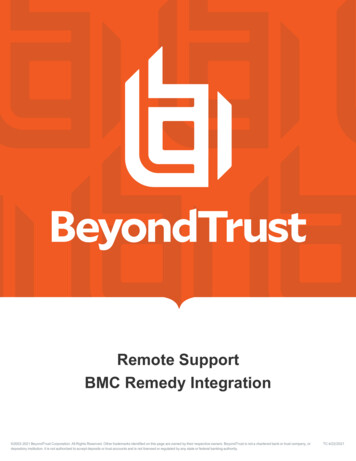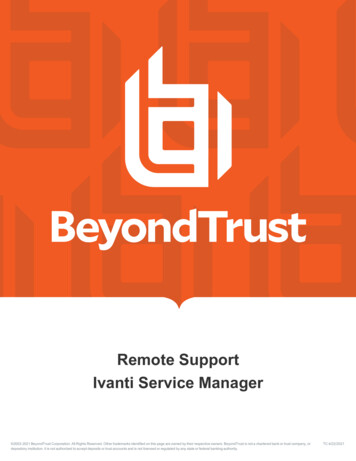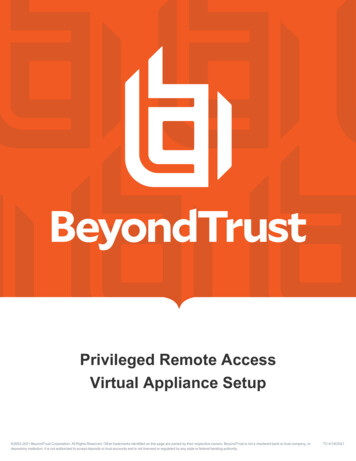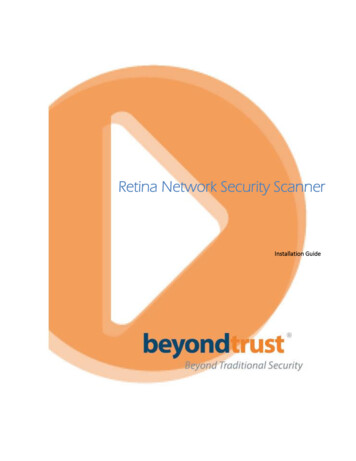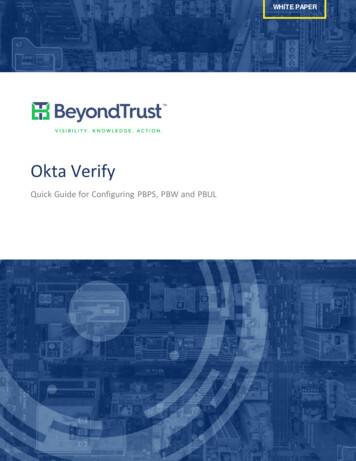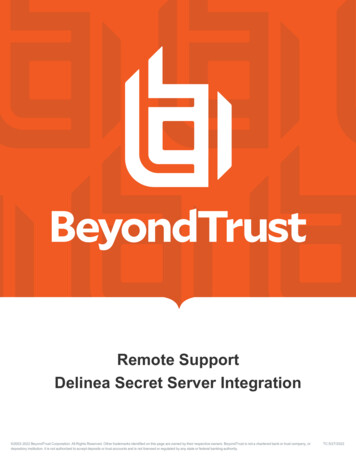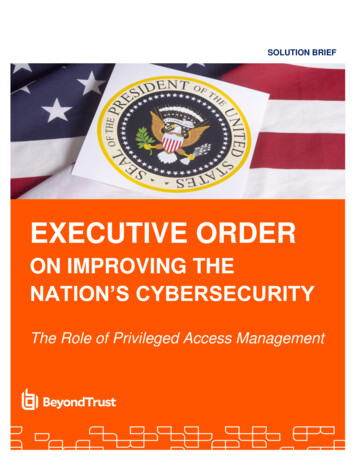
Transcription
SOLUTION BRIEFEXECUTIVE ORDERON IMPROVING THENATION’S CYBERSECURITYThe Role of Privileged Access Management
Executive Order on Improving the Nation’s CybersecurityThe Executive Order on Improving the Nation’s CybersecurityPresident Biden’s May 12, 2021 Executive Order (EO) has accelerated and highlightedthe crucial need to improve U.S. cybersecurity. The EO is inclusive of both guidelinesand timelines that agencies must meet to keep pace with the evolving threat landscape.Biden’s 2022 Fiscal Budget allocates 9.8 billion in cybersecurity funding to securefederal agencies.The EO is a direct response to a wave of widely disruptive cyberattacks in the first half of2021. According to a White House statement, “Recent cybersecurity incidents such asSolarWinds, Microsoft Exchange, and the Colonial Pipeline incident are a soberingreminder that U.S. public and private sector entities increasingly face sophisticatedmalicious cyber activity from both nation-state actors and cyber criminals. Theseincidents share commonalities, including insufficient cybersecurity defenses that leavepublic and private sector entities more vulnerable to incidents.”The Executive Order is an important step for the Biden administration’s efforts toenhance cybersecurity at the federal government level, including standardizingcybersecurity requirements and policies among agencies, and strengtheningcollaboration and cybersecurity information sharing with government contractors.Zero Trust and Software Supply Chain security approaches have been gainingmomentum within the federal sector and are key focus areas in the cybersecurity EO.Zero TrustWithin 60 days (of May 12, 2021), each agency must, “develop a plan to implement aZero Trust Architecture, which shall incorporate, as appropriate, the migration stepsthat the National Institute of Standards and Technology (NIST) within the Departmentof Commerce has outlined in standards and guidance.”Software Supply Chain SecurityAnother noteworthy component of the EO in Section 4: Enhancing Software SupplyChain Security is the focus on securing privileged accounts and credentials. The EOstates, “The security and integrity of ‘critical software’ — software that performsfunctions critical to trust (such as affording or requiring elevated system privileges or1
Executive Order on Improving the Nation’s Cybersecuritydirect access to networking and computing resources) — is a particular concern.Accordingly, the Federal Government must take action to rapidly improve the securityand integrity of the software supply chain, with a priority on addressing criticalsoftware.”In collaboration with the Cybersecurity and Infrastructure Security Agency (CISA), theOffice of Management and Budget (OMB), the Office of the Director of NationalIntelligence (ODNI), and the National Security Agency (NSA), NIST was charged withpublishing an updated definition of “critical software, conceptualizing a phasedimplementation, and a developing a preliminary list of common categories of softwarethat would fall within the scope for the initial phase.NIST defines “critical software” as “any software that has, or has direct softwaredependencies upon, one or more components with at least one of these attributes: Is designed to run with elevated privilege or manage privileges;Has direct or privileged access to networking or computing resources;Is designed to control access to data or operational technology;Performs a function critical to trust; or,Operates outside of normal trust boundaries with privileged access.While this EO is targeted at federal agencies, it is anticipated that other sectors willquickly adopt the requirements as embodying industry best practices.The Role of Privileged Access ManagementAs highlighted by NIST, Privileged Access Management (PAM) is arguably one of themost critical cybersecurity areas to get right. No identities are more imperative to securethan those with privileged access to systems, data, applications, and other sensitiveresources. Almost every attack today requires privilege for the initial exploit or tolaterally move within a network.PAM protects privileged credentials, granularly enforces least privilege, and monitorsand manages every session involving privileged access -- whether human, machine,employee or vendor.PAM solutions can protect agencies by:2
Executive Order on Improving the Nation’s Cybersecurity Implementing credential management best practices to prevent credentials frombeing stolen or misused. Enforcing least-privilege across users, applications, systems, etc. to drasticallyreduce the attack surface and minimize potential lateral access pathways. Ensuring elevated access is only given when contextual parameters are met and isimmediately revoked after the activity is performed or the context has changed. Securing remote access for employees or contractors -- without a VPN -- andenabling agencies to lock down access to cloud, virtual and DevOps controlplanes and other consoles. Monitoring and managing every privileged session, providing an unimpeachableaudit trail, and the ability to pause or terminate suspicious sessions.These core capabilities of a robust Privileged Access Management solution also helpenable a zero trust security posture. PAM reduces the threat surface and minimizes thethreat windows during which attackers can inflict damage, helping to protect againsteverything from simple malware to advanced persistent threats.Mapping BeyondTrust PAM Solutions to the Executive OrderBeyondTrust is the worldwide leader in Privileged Access Management, empoweringorganizations to secure and manage their entire universe of privileges.The EO requirements outlined in the following table are mapped to the BeyondTrustsolutions that help you meet the corresponding requirements: (PPM) Privileged Password Management - Enable automated discovery andonboarding of all privileged accounts, secure access to privileged credentials andsecrets, and audit all privileged activities. (SRA) Secure Remote Access - Apply least privilege and robust audit controls toall remote access required by employees, vendors, contractors, and servicedesks. (EPM) Endpoint Privilege Management - Combine privilege management andapplication control to efficiently manage admin rights on Windows, Mac, Unix,Linux, and network devices, without hindering productivity.3
Executive Order on Improving the Nation’s CybersecurityRequirementZero TrustArchitecture (3.a)BeyondTrustSolutionsHow BeyondTrust Can HelpBeyondTrust solutions deliver identity-centricsecurity that secures against both external andinternal threats and stands at the core of anyZero Trust strategy.PPMSRAEPM These solutions work together with ourBeyondInsight console to give agencies aunified view of actions, key stroke, analytics andreporting.Advancement ofCloud-basedSolutions (3.a)All of BeyondTrust’s solutions are available ascloud-based deployments, and BeyondTrusthas more PAM cloud customers than any othervendor. Planning for ZTA(3.b.ii)This section requires the development of a planto implement a Zero Trust Architecture,including prioritizing what needs to be done tomake the biggest impact. BeyondTrust’s network of federal integratorsand partners will work together with an agencyto develop a plan to implement a Zero TrustArchitecture. Because each solution can standalone, these plans can be customized toprioritize individual agency needs.Cloud with ZTA(3.c)This section states that, as agencies makecloud migration a priority, they shall implementcloud solutions a with Zero Trust Architecture. Not only are all BeyondTrust solutions availableas cloud deployments with features that enableZero Trust goals, BeyondTrust Cloud PrivilegeBroker is an entitlements and permissionsmanagement solution that enables agencies tovisualize and manage cloud access risk inhybrid and multicloud environments—all from asingle interface (available 2H 2021).Multi-FactorAuthentication (3.d)BeyondTrust’s Password Safe solution enablesagencies to implement segmentation rules tolegacy devices that may not currently supportMFA. By leveraging BeyondTrust, devices withoutnative support for MFA can only be accessed4
Executive Order on Improving the Nation’s CybersecurityRequirementBeyondTrustSolutionsHow BeyondTrust Can HelpPPMSRAEPM leveraging an MFA-enabled solution. Thisallows the continued use of devices that wouldotherwise be non-compliant.Risk BasedAuthentication(4.e.i.C)This section requires NIST to publishpreliminary guidelines for the security of thesoftware supply chain, and specifically dictatesestablishing “multi-factor, risk-basedauthentication and conditional access acrossthe enterprise. ”BeyondTrust’s solution not only support MFA,but also can support integration with solutionslike Virus Total. These capabilities, along withlocation awareness on login, allow forsupporting risk-based authentication andconditional access.Least Privilege (4.i)This section requires NIST to publish guidelinesfor critical software including “applying practicesof least privilege.” Enabling least privilege is a fundamentalcapability of the BeyondTrust PAM solution,removing excessive end user privileges andeliminating local admin rights and root access.5
Executive Order on Improving the Nation’s CybersecurityThe Beyondtrust Privileged Access Management SolutionThe BeyondTrust Privileged Access Management portfolio is an integrated solution setthat provides visibility and control over the entire universe of privileges—identities,endpoints, and sessions.BeyondTrust delivers what industry experts consider to be the complete spectrum ofprivileged access management solutions. In the Gartner Magic Quadrant for PrivilegedAccess Management, BeyondTrust is named as a leader for all solution categories in thePAM market.BeyondTrust’s Universal Privilege Management model provides the most practical,complete, and scalable approach to protecting privileged identities (human andmachine), endpoints, and sessions by implementing comprehensive layers of security,control, and monitoring. The complete BeyondTrust solution allows you to address theentire journey to Universal Privilege Management, to drastically reduce your attacksurface and threat windows.By uniting the broadest set of privileged security capabilities, BeyondTrust simplifiesdeployments, reduces costs, improves usability, and reduces privilege risks.6
Executive Order on Improving the Nation’s CybersecurityABOUT BEYONDTRUSTBeyondTrust is the worldwide leader in Privileged Access Management (PAM),empowering organizations to secure and manage their entire universe of privileges. Ourintegrated products and platform offer the industry's most advanced PAM solution,enabling organizations to quickly shrink their attack surface across traditional, cloudand hybrid environments.The BeyondTrust Universal Privilege Management approach secures and protectsprivileges across passwords, endpoints, and access, giving organizations the visibilityand control they need to reduce risk, achieve compliance, and boost operationalperformance. Our products enable the right level of privileges for just the time needed,creating a frictionless experience for users that enhances productivity.With a heritage of innovation and a staunch commitment to customers, BeyondTrustsolutions are easy to deploy, manage, and scale as agencies evolve. We are trusted by20,000 customers, including 70 percent of the Fortune 500, and a global partnernetwork.Learn more at beyondtrust.com.V2021 06 ENG7
privileged access management solutions. In the Gartner Magic Quadrant for Privileged Access Management, BeyondTrust is named as a leader for all solution categories in the PAM market. BeyondTrust's Universal Privilege Management model provides the most practical, complete, and scalable approach to protecting privileged identities (human and
